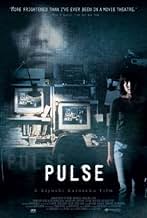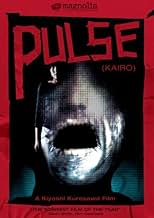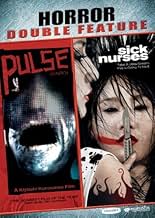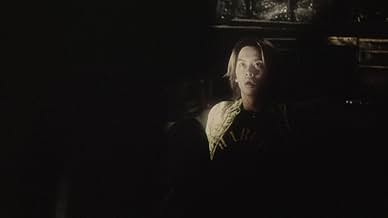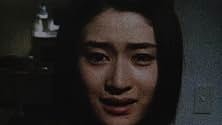Dois grupos de pessoas descobrem evidências que sugerem que espíritos podem estar tentando invadir o mundo humano por meio da Internet.Dois grupos de pessoas descobrem evidências que sugerem que espíritos podem estar tentando invadir o mundo humano por meio da Internet.Dois grupos de pessoas descobrem evidências que sugerem que espíritos podem estar tentando invadir o mundo humano por meio da Internet.
- Prêmios
- 3 vitórias e 3 indicações no total
Avaliações em destaque
I really like the slow and ominous atmosphere of Kairo, especially its depiction of Japan's late 90s and early 2000s aesthetics, including early internet culture and architectural design. The film features some excellent decor shots that enhance its eerie and nostalgic feel.
Fun fact: Kiyoshi Kurosawa, known for his work in horror, actually started his career directing pink films, which are a genre of Japanese softcore adult movies. This diverse background contributed to his unique approach to creating tension and atmosphere in his later works.
I give this film a 6/10 mostly because i love the aesthetics from the early 2000s.
-Concept (Idea Premise, Worldbuilding, Theme) 7.0 -Plot (A,B,C, Writing) 6.0 -Acting 5.8 -Dialogue(Character development, Plot advancement, Natural-sounding, Consistency, Looping(ADR)) 5.6 -Fun 5.2 -Decor (Aesthetic, Graphics VFX, Scenery/Location, Scenes, Shots, Stage Set, Mise en Scène, Directing) 8.2 -Overall 6.3.
Fun fact: Kiyoshi Kurosawa, known for his work in horror, actually started his career directing pink films, which are a genre of Japanese softcore adult movies. This diverse background contributed to his unique approach to creating tension and atmosphere in his later works.
I give this film a 6/10 mostly because i love the aesthetics from the early 2000s.
-Concept (Idea Premise, Worldbuilding, Theme) 7.0 -Plot (A,B,C, Writing) 6.0 -Acting 5.8 -Dialogue(Character development, Plot advancement, Natural-sounding, Consistency, Looping(ADR)) 5.6 -Fun 5.2 -Decor (Aesthetic, Graphics VFX, Scenery/Location, Scenes, Shots, Stage Set, Mise en Scène, Directing) 8.2 -Overall 6.3.
I don't want to give away anything about this wonderful, haunting film. If you liked "The Sixth Sense", "The Others" or "Ring", this will show you how those films pale in comparison. I felt my skin crawl so many times, and the movie has been haunting my thoughts for days now. I sincerely hope that a wider audience has a chance to experience this dark, beautiful film.
A cold, creepy & confounding horror that unfortunately overstays its welcome in the end, Pulse (also known as Kairo) is downright eerie during the first act as it creates an ominous aura of dread & uncertainty with its uncanny premise, freaky imagery & inexplicable body counts but thanks to its glacial pace, uninviting quality & overlong runtime, sitting through it is a slog.
Written & directed by Kiyoshi Kurosawa, the film is devoid of cheap tricks & clichéd elements that plague most horror films and makes for an interesting examination of isolation & loneliness. Kurosawa allows plenty of space for the plot to unravel but it also slows down the narrative by a considerable extent. And with no deftly scripted character to latch on to, it becomes an infuriating journey.
Also lessening the overall impact is the uneven script & seemingly opaque structure that has our curiosity at first but slowly loses it as the story crawls towards the finish line. An added focus on a single storyline instead of two, a steadier pace than usual & a bit more transparency could've enhanced the overall experience without diluting its effectiveness. It is 119 mins long on paper but feels twice as lengthy.
Overall, Pulse isn't going to appeal to everyone's taste but for those who have the endurance to sit through this chore and patiently connect with what Kurosawa was going for here may find the ride rewarding. The snail-paced narration is probably a deliberate choice but it also alienates the film from a wider viewership. Nonetheless, for those who are sick & tired of the typical, predictable & thinly layered horror films, Pulse might just be what they are looking for.
Written & directed by Kiyoshi Kurosawa, the film is devoid of cheap tricks & clichéd elements that plague most horror films and makes for an interesting examination of isolation & loneliness. Kurosawa allows plenty of space for the plot to unravel but it also slows down the narrative by a considerable extent. And with no deftly scripted character to latch on to, it becomes an infuriating journey.
Also lessening the overall impact is the uneven script & seemingly opaque structure that has our curiosity at first but slowly loses it as the story crawls towards the finish line. An added focus on a single storyline instead of two, a steadier pace than usual & a bit more transparency could've enhanced the overall experience without diluting its effectiveness. It is 119 mins long on paper but feels twice as lengthy.
Overall, Pulse isn't going to appeal to everyone's taste but for those who have the endurance to sit through this chore and patiently connect with what Kurosawa was going for here may find the ride rewarding. The snail-paced narration is probably a deliberate choice but it also alienates the film from a wider viewership. Nonetheless, for those who are sick & tired of the typical, predictable & thinly layered horror films, Pulse might just be what they are looking for.
A group of young people in Tokyo begin to experience strange phenomena involving missing co-workers and friends, technological breakdown, and a mysterious website which asks the compelling question, "Do you want to meet a ghost?"
Director Kiyoshi Kurosawa spent years working in the world of "pink" films and direct-to-video movies. He was at this time best known in the west for "Cure" (1997), though it was "Pulse" that would make him an international sensation. Assisting him is cinematographer Junichiro Hayashi, known for two other J-horror modern classics, "Ring" and "Dark Water".
"Pulse" was released at the right time for American audiences to latch on to. The American version of "The Ring" came out in 2002, and sparked a wider interest in Japanese horror, kicking off a wave of remakes. This also helped get the originals a wider distribution in the States -- "Pulse" being among those, as well as "Audition" and many of the Takashi Miike films that had previously been very niche.
Kurosawa uses this film not just to tell a good ghost story, but to explore "the horror of isolation" in a world of increased inter-connectivity. With its dreary, depressing color palette and empty space, we find this story about the Internet to truly be about loneliness. Whether intentional or not, it is a clever social commentary that may be more true today (2017) than it was at the time.
Some early reviews were critical because the film is heavier on style than substance and the narrative is not completely coherent. But since then, praise has only grown. In 2012, Jaime Christley of Slant magazine listed the film as one of the greatest of all time. In the early 2010s, Time Out conducted a poll with several authors, directors, actors and critics who have worked within the horror genre to vote for their top horror films. "Pulse" placed at number 65 on their top 100 list.
The Arrow Video Blu-ray is a fine package and a great excuse to re-visit this film. Contents include (but are not limited to) new interviews with writer/director Kiyoshi Kurosawa (at an astounding 43 minutes!), actor Show Aikawa and cinematographer Junichiro Hayashi (24 minutes); "The Horror of Isolation", a new video appreciation featuring Adam Wingard and Simon Barrett; an archive 'making of' documentary, plus four archive behind-the-scenes featurettes.
Director Kiyoshi Kurosawa spent years working in the world of "pink" films and direct-to-video movies. He was at this time best known in the west for "Cure" (1997), though it was "Pulse" that would make him an international sensation. Assisting him is cinematographer Junichiro Hayashi, known for two other J-horror modern classics, "Ring" and "Dark Water".
"Pulse" was released at the right time for American audiences to latch on to. The American version of "The Ring" came out in 2002, and sparked a wider interest in Japanese horror, kicking off a wave of remakes. This also helped get the originals a wider distribution in the States -- "Pulse" being among those, as well as "Audition" and many of the Takashi Miike films that had previously been very niche.
Kurosawa uses this film not just to tell a good ghost story, but to explore "the horror of isolation" in a world of increased inter-connectivity. With its dreary, depressing color palette and empty space, we find this story about the Internet to truly be about loneliness. Whether intentional or not, it is a clever social commentary that may be more true today (2017) than it was at the time.
Some early reviews were critical because the film is heavier on style than substance and the narrative is not completely coherent. But since then, praise has only grown. In 2012, Jaime Christley of Slant magazine listed the film as one of the greatest of all time. In the early 2010s, Time Out conducted a poll with several authors, directors, actors and critics who have worked within the horror genre to vote for their top horror films. "Pulse" placed at number 65 on their top 100 list.
The Arrow Video Blu-ray is a fine package and a great excuse to re-visit this film. Contents include (but are not limited to) new interviews with writer/director Kiyoshi Kurosawa (at an astounding 43 minutes!), actor Show Aikawa and cinematographer Junichiro Hayashi (24 minutes); "The Horror of Isolation", a new video appreciation featuring Adam Wingard and Simon Barrett; an archive 'making of' documentary, plus four archive behind-the-scenes featurettes.
What could have been just another RING rip-off turns out to be one of the most thought-provoking and genuinely eerie films I've seen come out of Japan: it's a film in which the door between the living and the dead is accidentally opened, leading to all manner of sinister events as it transpires that the dead are returning to Earth.
Like most J-horrors of the past decade, PULSE is a slow burner that moves almost glacially, gradually slotting in the various pictures of the jigsaw as its final game plan becomes apparent. Saying too much would spoil the intriguing, dream-like narrative, suffice to say that this is a film that doesn't disappoint at any stage during its progress. The 'ghost' segments are supremely creepy and disturbing, countered neatly by shock suicide scenes and a clever bit of FX involving a plane that was later cribbed for Alex Proyas's Hollywood movie KNOWING.
The cast give typically understated performances that increase in intensity as the character list is gradually whittled down, leading to one heck of a grim climax. Altogether, I can't fault the direction, writing, acting as all three combine to deliver an imaginative and thoughtful ghost story that's extremely different from most of what's come before.
Like most J-horrors of the past decade, PULSE is a slow burner that moves almost glacially, gradually slotting in the various pictures of the jigsaw as its final game plan becomes apparent. Saying too much would spoil the intriguing, dream-like narrative, suffice to say that this is a film that doesn't disappoint at any stage during its progress. The 'ghost' segments are supremely creepy and disturbing, countered neatly by shock suicide scenes and a clever bit of FX involving a plane that was later cribbed for Alex Proyas's Hollywood movie KNOWING.
The cast give typically understated performances that increase in intensity as the character list is gradually whittled down, leading to one heck of a grim climax. Altogether, I can't fault the direction, writing, acting as all three combine to deliver an imaginative and thoughtful ghost story that's extremely different from most of what's come before.
Você sabia?
- CuriosidadesTakashi Miike has said that this is the only film that has frightened him as an adult.
- Erros de gravaçãoRyosuke is typing in a numerical password to log in to his computer to watch videos on the dark web as shown on his screen. When it cuts to a shot of him typing on his keyboard however, he is pressing letters instead of numbers.
- Citações
Ghost: Death was... eternal loneliness.
- Versões alternativasRemade in America with the same (English) title, starring Kristen Bell, in 2006.
- Trilhas sonorasHane Lay Down My Arms
Performed by Cocco
Principais escolhas
Faça login para avaliar e ver a lista de recomendações personalizadas
- How long is Pulse?Fornecido pela Alexa
Detalhes
Bilheteria
- Faturamento bruto nos EUA e Canadá
- US$ 51.420
- Fim de semana de estreia nos EUA e Canadá
- US$ 7.250
- 13 de nov. de 2005
- Faturamento bruto mundial
- US$ 319.233
Contribua para esta página
Sugerir uma alteração ou adicionar conteúdo ausente








